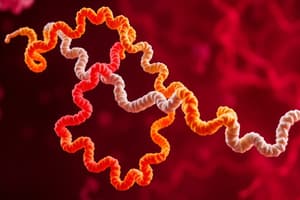Podcast
Questions and Answers
What is the format of the PDB ID?
What is the format of the PDB ID?
- 6 numeric characters
- 5 alphanumeric characters
- 3 alphabetic characters
- 4 alphanumeric characters (correct)
What would happen if you were to open a PDB file without a proper tool?
What would happen if you were to open a PDB file without a proper tool?
- The file will be encrypted
- The file will be read as a text file (correct)
- The file will be corrupted
- The file will open as a 3D image
What is the purpose of databases like SCOP, HSSP, and CATH?
What is the purpose of databases like SCOP, HSSP, and CATH?
- To store 3D protein structures
- To simulate protein-protein interactions
- To predict protein functions
- To classify and analyze protein structures (correct)
What type of file extension do atomic coordinate files have?
What type of file extension do atomic coordinate files have?
What is the purpose of molecular graphics visualization tools?
What is the purpose of molecular graphics visualization tools?
What is the primary function of the Nucleic Acid Structure Database (NDB)?
What is the primary function of the Nucleic Acid Structure Database (NDB)?
What is the name of the international repository of macromolecular structure data established in 1972?
What is the name of the international repository of macromolecular structure data established in 1972?
What method is used to determine the structural information of a protein?
What method is used to determine the structural information of a protein?
What type of information can be found in a PDB file?
What type of information can be found in a PDB file?
Who maintains the Protein Data Bank (PDB)?
Who maintains the Protein Data Bank (PDB)?
What can be done with the information available in the PDB?
What can be done with the information available in the PDB?
Flashcards are hidden until you start studying
Study Notes
Protein Databank (PDB)
- Established in 1972 at Brookhaven National Laboratory (BNL)
- Sole international repository of macromolecular structure data
- Moved to Research Collaboratory for Structural Bioinformatics (http://www.rcsb.org)
Nucleic Acid Structure Database (NDB)
- Contains information about experimentally-determined nucleic acids and complex assemblies
- Allows searches based on annotations relating to sequence, structure, and function
- Enables downloading, analysis, and learning about nucleic acids (http://ndbserver.rutgers.edu/)
Protein Structure Database
- Contains information about 3D structure of proteins
- PDB files contain experimentally-determined 3D structures of biological macromolecules
- Structural information can be determined by X-ray crystallography or Nuclear Magnetic Resonance (NMR) spectroscopy methods
Features of PDB
- Allows searching for information regarding structure, sequence, function, and visualization
- Enables downloading and assessing molecules
- PDB files contain data collected, molecule name, primary and secondary structure, ligand, atomic coordinates, crystallographic structure factors, and NMR experimental data
Data Submission and Access
- Data submitted by scientists from all over the world
- Maintained by Worldwide Protein Data Bank
- All data in PDB are accessible to the public
- Each entry in PDB is provided with a unique identification number called the PDB ID (4-letter alphanumeric code)
Derived Databases
- Structural Classification of Proteins (SCOP) groups different protein structures
- Homology-Derived Secondary Structure of Proteins (HSSP) provides 3D-structure and 1D-sequence of proteins
- CATH classifies protein structures according to their evolution
Protein Visualization Tools
- Required to view and manipulate 3D structures encoded by PDB files (.pdb)
- Enables visualization of molecules from various perspectives
Studying That Suits You
Use AI to generate personalized quizzes and flashcards to suit your learning preferences.




